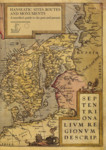
Hanseatic sites, routes and monuments
1996
144 lk
Sisukord:Keskaja lõpus moodustunud Hansa Liit oli Põhja-Euroopa kaubanduse ja ühiskonna arengule olulisim tegur. Läbi Hansa Liidu olid omavahel seotud idas Novgorodi kaupmehed ja läänes London ning Põhja-Saksamaa linnad, Holland ja Belgia. Keskaja kõige põhilisem laevatüüp koge sai Hansa Liidu tegevuse sümboliks. Nende laevade abil oli võimalik transportida kaupu ka sinna, kuhu varem ei olnud võimalik. Üks Euroopa Nõukogu ülesandeid on süvendada kultuurikontakte erinevate Euroopa rahvaste vahel. Seetõttu juhib Euroopa Nõukogu ka tähelepanu keskaegse Euroopa olulisematele kaubateedele ja reisisihtkohtadele. Kaasaegsete fotode ja vanade gravüüridega illustreeritud reisijuht annab ülevaate Hansa Liitu kuulunud linnadest ja kaubateedest Euroopas alates 1230. aastast. Omaette peatükk on pühendatud ka Tallinnale. The Hanseatic League was founded in Germany - in the Rhine area and firmly on the coast of the Baltic sea in the 12th century. It rapidly grew into an international trade-organisation, which developed enormous political and economical power. The Hanseatic League dominated northern Europe for about 500 years and was spread in England, the Nordic countries, Russia, Estonia, Latvia, Lithuania, Poland, the Netherlands and Belgium. The last Diet (meeting) within the League was held in Lübeck in 1669.
From the many towns connected with the Hanseatic League, only a small Hanseatic times, the presence of an original street plan, and the actual condition of the medieval and 16th and 17th century monuments. The main criterion together with all these factors is the presence of the difficultly defineable "ancient atmosphere".
Selle raamatu lisa info
Kapp:
Riiul:
Rida:
Riiul:
Rida:
Seisukord

